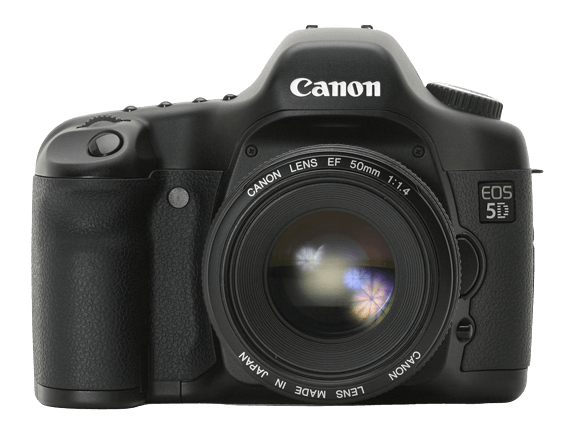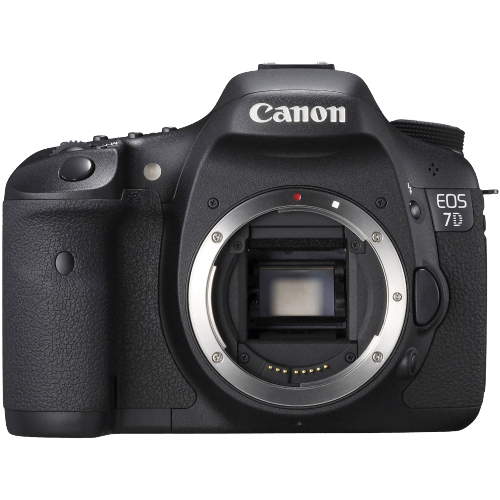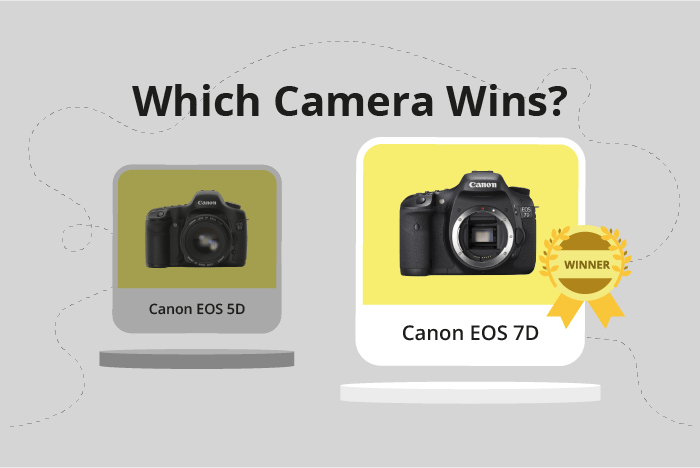Canon EOS 5D vs EOS 7D Comparison
Canon EOS 5D

Canon EOS 7D

The Canon EOS 7D comes out on top with a score of 45/100, while the Canon EOS 5D trails behind with a score of 40/100. Both cameras are DSLRs, and they share similar dimensions and weight, with the 7D being slightly lighter and smaller. They were released a few years apart, with the 5D in 2005 and the 7D in 2009. The launch prices were almost the same, with the 7D being slightly cheaper at $1974 compared to the 5D’s $2000.
The Canon EOS 7D’s higher score means it has better features, making it a more desirable camera for photographers. However, the Canon EOS 5D still has its merits, especially considering its age. Despite being an older model, the 5D can still deliver quality results for those who prefer its specific features or are on a budget.
After evaluating the general specifications, the Canon EOS 7D is the better camera due to its higher score and more advanced features. However, the Canon EOS 5D remains a viable option for those who value its unique characteristics or are looking for a more affordable option.
Canon EOS 5D vs EOS 7D Overview and Optics
The Canon EOS 5D takes the lead in optics with a score of 46/100, while the Canon EOS 7D trails behind with a score of 43/100. Both cameras have a few similarities in their specifications, such as the CMOS sensor type, the absence of image stabilization, and the compatibility with Canon EF lenses.
The Canon EOS 5D outshines the EOS 7D in certain aspects. It features a full-frame sensor, which provides a larger sensor area, resulting in better image quality and low-light performance. Additionally, the 5D has a higher DXOMARK score for the sensor, standing at 71 compared to the 7D’s 66, signifying superior overall image quality.
On the other hand, the Canon EOS 7D boasts some advantages over the 5D. It has a higher megapixel count of 18, allowing for more detailed images and larger prints. The 7D also has a more advanced processor, the Dual Digic 4, which enables faster processing and better image quality. Moreover, the 7D’s shooting speed of 8 frames per second is significantly faster than the 5D’s 3 frames per second, making it more suitable for action photography.
Taking these factors into account, the Canon EOS 5D is the better choice for photographers seeking superior image quality and low-light performance, thanks to its full-frame sensor and higher DXOMARK score. However, the Canon EOS 7D is a more versatile option for those who require faster shooting speeds, greater detail, and a more advanced processor.
Canon EOS 5D vs EOS 7D Video Performance
When comparing the video capabilities of the Canon EOS 5D and the Canon EOS 7D, it is essential to note that the Canon EOS 5D does not have any video functionality. Therefore, this comparison will focus on the video capabilities of the Canon EOS 7D.
The Canon EOS 7D offers a video score of 43 out of 100. It provides Full HD video resolution, with maximum dimensions of 1921 x 1080 pixels. The camera’s maximum video frame rate is 30 frames per second (fps). However, it is important to note that the Canon EOS 7D does not have built-in time-lapse functionality.
Considering the video capabilities of the Canon EOS 7D, it is clear that this camera offers basic video features suitable for casual users. The lack of video functionality in the Canon EOS 5D makes the Canon EOS 7D the superior choice for those interested in capturing video content.
Canon EOS 5D vs EOS 7D Features and Benefits
The Canon EOS 7D surpasses the Canon EOS 5D in features, scoring 54/100 compared to the 5D’s 30/100. Both cameras share some specifications, such as the absence of a touchscreen, flip screen, GPS, and Bluetooth. However, there are clear differences that set the 7D ahead of the 5D in terms of features.
The EOS 7D boasts a larger screen size of 3 inches, while the 5D has a 2.5-inch screen. Additionally, the 7D’s screen resolution is significantly higher with 920,000 dots compared to the 5D’s 230,000 dots. This difference provides the 7D with a clearer and more detailed display for better image review and camera control.
The 5D has one advantage over the 7D: it features Wi-Fi connectivity, allowing users to transfer files wirelessly and control the camera remotely. The 7D lacks this convenient feature. Despite this, the 7D’s overall feature set remains superior due to the larger screen and higher resolution.
Considering these points, the Canon EOS 7D offers better features than the Canon EOS 5D. The larger screen and higher resolution make it more user-friendly and enhance the overall shooting experience. Although the 5D has Wi-Fi, it falls short in other areas, making the 7D a more appealing option for photographers seeking a feature-rich camera.
Canon EOS 5D vs EOS 7D Storage and Battery
The Canon EOS 7D outperforms the Canon EOS 5D in storage and battery with a score of 35/100, compared to the 5D’s 24/100. Both cameras have one memory card slot and do not support USB charging. They also accept Compact Flash (Type I or II) memory cards.
The EOS 7D has an advantage with its extended battery life, offering 800 shots per charge, while the 5D only provides 400 shots. Additionally, the 7D is compatible with UDMA and Microdrive memory cards, which expands its storage capabilities. Its battery type is LP-E6, which is different from the 5D’s BP-511A.
The EOS 5D, however, does not have any distinct advantages in storage and battery compared to the 7D.
Considering these points, the Canon EOS 7D is the superior choice for storage and battery performance, primarily due to its longer battery life and wider range of memory card compatibility.
Alternatives to the Canon EOS 5D and EOS 7D
Are you still undecided about which camera is right for you? Have a look at these popular comparisons that feature the Canon EOS 5D or the Canon EOS 7D:

